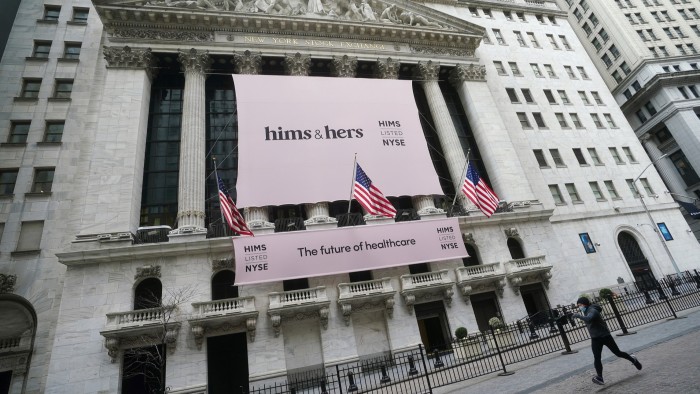Unlock the Editor’s Digest for free
Roula Khalaf, Editor of the FT, selects her favourite stories in this weekly newsletter.
About five years ago, special purpose acquisition companies — or Spacs — were all the rage in the US. Start-ups light years away from profitability went public by merging with these listed cash shells. Today, 92 per cent of them trade below their launch price, according to data company ListingTrack.
One company that has managed to avoid this fate is Hims & Hers Health. The direct-to-consumer digital health platform, which got its start selling erectile dysfunction and hair-loss medications, merged with a Spac backed by Oaktree Capital Management in 2021. Its share price has quintupled. By contrast, consumer brand Playboy, which announced a merger with a Spac on the very same day, has lost almost 90 per cent of its value.
The reason for Hims’ outperformance? Weight-loss drugs, also known as GLP-1. The company began selling compounded versions of semaglutide, the active ingredient in Novo Nordisk’s blockbuster weight-loss injection Wegovy and diabetes treatment Ozempic, online in May 2024. The shares, which had largely traded sideways until then, surged as investors jumped on an alternative to Novo and Eli Lilly and their richly valued stock.
Demand for Hims’ copycat injection, which sold for $199 a month compared with the $1,300-plus listed price of Novo’s Wegovy, drove a 69 per cent rise in revenue to almost $1.5bn last year, and the company’s first annual profit.
The flaw in this model is that compounded drugs — made with the same basic ingredient as branded drugs but by a specialised pharmacy rather than a drug company — are only permitted by regulators during shortages. And in February, the Food and Drug Administration declared that shortages of Wegovy and Ozempic had been resolved. Hims’ stock collapsed.
Like the hairlines of its male customers, Hims’ business is sprouting back. It has struck a partnership with Novo to sell Wegovy on its platform and reiterated its forecast for total group revenue to jump 63 per cent this year to between $2.3bn and $2.4bn. The company also introduced a 2030 target of at least $6.5bn in revenue, implying average annual growth of about 22 per cent every year between 2026 and 2030.
To get there, Hims will need to be more than just another distributor of Wegovy. Rival telehealth platforms Ro and LifeMD have also made deals with Novo to sell the drug. Customers who have grown accustomed to paying under $200 for compounded GLP-1 may not be able to make the leap to pricer brand-name offerings.
Hims could drum up more revenue by cross-selling services, such as skincare, to new subscribers. The company has already shown it has the ability to pivot smartly, making it the fourth-best performer of the Spac boom, according to ListingTrack data. Hims’ customers may be improving with age; very few of its contemporaries can make such a claim.
